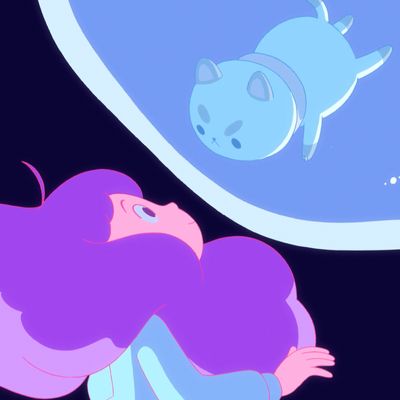
Despite having zero Hollywood clout, no major awards, and little risk of ever being described as a household name, Natasha Allegri recently made filmmaking history. She raised $872,133 for her surreal animated web series, Bee and PuppyCat. Not only does that make her the sixth-most successful filmmaker on Kickstarter (bested only by Spike Lee, Zach Braff, the Veronica Mars movie, and other big names), it also makes her its most successful woman filmmaker. It’s safe to say Allegri and her series are cult phenomena.
Bee and PuppyCat is difficult to describe, which is part of its charm. It debuted in July of 2013 on Cartoon Hangover, a YouTube network of animated series run by a company called Frederator. Allegri, who was at the time working on the hit cartoon Adventure Time, crafted a two-part saga about an unemployed woman named Bee (voiced by actress Allyn Rachel) and a strange half-dog/half-cat creature she finds, thereafter known as “PuppyCat.” PuppyCat speaks in a strange, electronic lilt created not through voice recording but rather through a computer algorithm called a “Vocaloid.” PuppyCat and Bee end up going on cosmic temp jobs such as babysitting a planet-size fish named Wallace. But the pilot episodes’ true charm came in the odd dialogue, especially that of Bee, who mumbles a lot to herself and involuntarily slips into weird voices. Again, it’s hard to describe, but it’s oddly compelling.
And now, after more than a year of waiting, fans are finally getting what they paid for. Cartoon Hangover will debut the first episode of the first full season of Bee and PuppyCat tonight, and Vulture caught up with Allegri to talk about dogs, turtles, and holographic Japanese pop stars.
The dialogue in Bee and PuppyCat is unusually, almost unsettlingly naturalistic. Which of Bee’s lines have you said in real life?
Oh yeah, there’s a lot, actually. She says “hello” like a parrot. That’s basically me and my roommate. When I used to live with her, we would just walk into each other’s rooms and say that. I think what’s really important to me is people talking like how they talk, so when someone is stumbling through a word, that’s really, like, a special moment! A lot stuff comes from how people talk in anime.
I don’t follow. How is the dialogue like anime?
At least in the anime that I watch, people talk and their conversation goes in a natural flow. They can talk about one topic and then maybe steer it to a different direction. People get easily excited and then become very — I don’t know what the word is, but they’re like, “[dour voice] I’m going to do that, and [excited voice] I’m going to try to look good!” They’re not preachy, but they will treat their emotion changes very naturally.
Why call the animal “PuppyCat”? Is there a real-life puppy or cat you based it on?
I want to keep talking about anime.
Okay! Talk as much about anime as you like.
So, when they come up with new Pokémon, they try to think of syllables that sound cute. So there are a lot of pa sounds or po sounds that have cute and short little sounds. You usually avoid a guttural sound. You don’t want to put a na or a guh in there. So “PuppyCat” is, like, pretty cute sounds put together. I wanted the word itself to sound cute and make you happy when you hear it.
So the word PuppyCat came before the idea of having something that is part puppy and part cat?
Yeah! Yes.
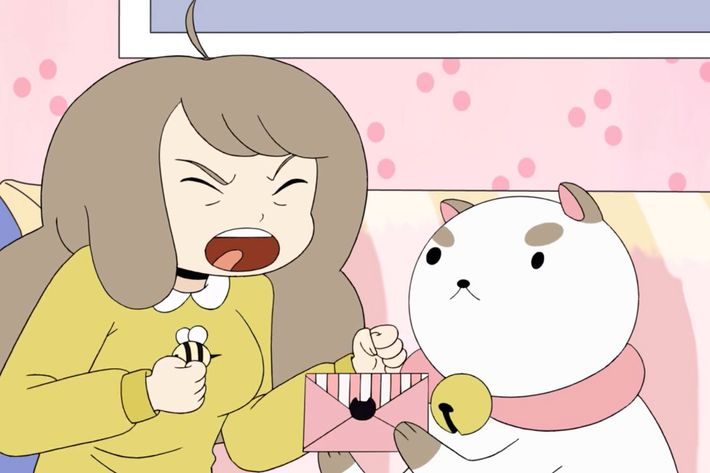
But you then had to come up with visuals for PuppyCat, of course, and for Bee. What was your first doodle for the series, and when did it happen?
The first doodle was right after [Frederator] contacted me to pitch. I just sat down and I — I think they came out right away! Bee got chubbier as time went on, because my style changed and I think chubby things are really cute. PuppyCat kind of stayed the same. I had to make him look like a dog with dog markings, but I think I got those backward.
Wait, what does it mean to have dog markings “backward”?
So you know the Shiba Inu? The one with the curly tail and little eyebrows over its head?
Of course.
I didn’t even bother to google it. I was just like, Oh, I’ll just draw it how I remember it, and I remembered it wrong. So the fur colors are reversed and the eyebrows are wrong.
Speaking of eyebrows: PuppyCat always looks so disapproving. Is he actually mad all the time?
No, that’s just his eyebrows. He’s, like, very stern, but no, he’s not mad. But that means everyone thinks he’s mad, so maybe that’s why he’s so stern all the time.
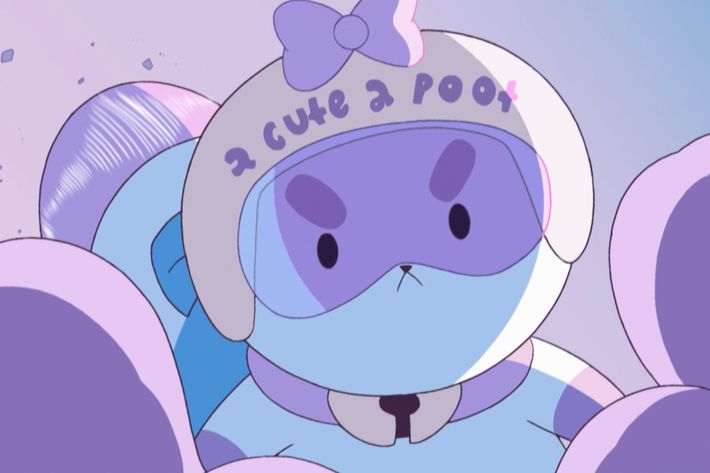
The most distinctive part of PuppyCat, though, is his voice, which is very singsongy and synthesizer-y. How did you create that?
It’s a Vocaloid, and a Vocaloid is like a sound string of computer-generated syllables that make sound. You Auto-Tune them, lengthen them, and shorten them to make sound. There’s a Vocaloid named Hatsune Miku —
Oh! The Japanese pop star who’s just a computer-generated hologram?
Yeah! Whenever I talk about Vocaloids, if I don’t hear anything [from the person I’m talking to], as soon as I mention Hatsune Miku everyone is like, “Oh yeah!” [Laughs.] Around the time she had started, I was really into J-Pop and then she started doing concerts and me and my friend Patrick would google the concerts and watch them on YouTube. Then there’s always related videos on YouTube after you watch it and you just start clicking and going down the hole of Vocaloids on YouTube. And then based on that, oh there are so many different kinds! I picked a favorite and I was like, If I ever make anything, I will use my favorite Vocaloid in the thing. And I did.
What’s the name of the Vocaloid you use?
OLIVER.
How much control over the Vocaloid do you have? Do you, like, type in speech for it to say?
If you type in a word, it breaks it up by syllables. You can change its pitch, but not too much. The way he says each syllable, that’s kind of how you get it. You can put breaths in; they recorded them like inhaling, which is really cool. You can time it as much as you want. You can try and get them to say words; you could pitch up the syllable to modify the word you want them to say, and you can have pretty good control.
[Editor’s note: Vocaloid construction and manipulation is, as you might guess from Allegri’s description, extremely difficult for a layperson to understand. Here’s a tutorial video, in case you’re interested in learning more.]
How long did it take you to make the two Bee and PuppyCat shorts that debuted on Cartoon Hangover?
The first two shorts, I think, took a year. I don’t know for sure. I don’t remember. I was still working on Adventure Time at the same time.
When it first went up, what surprised you most about people’s response to it?
How many girls were like, “Oh, that’s me.” I was super stoked that people could identify with [Bee] so much or even a little bit. That was the best part.
Where were you and what were you doing when you found out the Kickstarter had reached its initial funding goal?
[Long pause.] Shit.
You’d think this would be embedded in your brain.
I don’t know where I was! I used to live in this guest house and I think it was really cold around that time. I want to say it was still winterish and I had just bought these boots that were really soft and warm, and that is the thing I remember about that time most, these amazing boots.
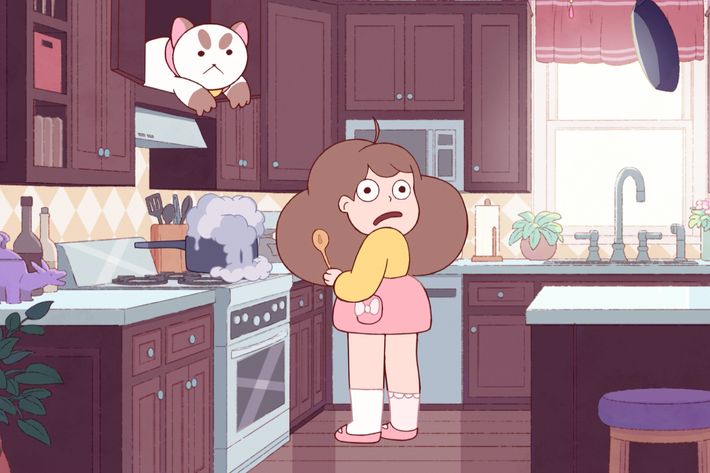
So the main thing you remember about your Kickstarter victory is that you were wearing your special boots?
Yeah! [Laughs.] They never came off. Like, I was still wearing them when it was inappropriate to be warm, and I was like, No they are really soft, it is okay. But they were making me sweat. Like crazy, crazy sweaty.
Then after that, the Kickstarter went on to make nearly $900,000, which made it the most-funded web series in Kickstarter history. How did you feel when you hit that milestone?
I’m not sure. I just remember someone saying, like, you beat Video Game High School, and I remember being really depressed because I really like Video Game High School!
The initial episodes ended on this cliffhanger about PuppyCat’s true identity and whether he was a fairy-tale prince who went through some serious love-story trauma. Are we going to get resolution on that this season?
I think that’s such a large story that it is something that can be told over time. You want to see how it has affected PuppyCat more than you want a resolution to that fairy tale. At least I do, because I feel like what it does to someone is more interesting than the actual story. What it is for someone to live with something like that. But I mean the short answer is [you’ll learn] a little bit, but not too much.
But I’m sure you’ve had fans accost you and demand that you tell them how the cliffhanger plays out, right?
Yeah, and I don’t know how to answer it! All I can say is that if I told you everything, that’s not fair. But I understand and I want to put more.
Your animation style is very obviously influenced by Hayao Miyazaki. What’s your favorite Miyazaki movie of —
Oh my God, Kiki’s Delivery Service. Like, that is super easy because I watch it once a month.
I wasn’t expecting such a swift answer.
I love them all, but my favorite, my absolute favorite is Kiki’s Delivery Service. There’s something about how slow it is and how quiet and beautiful [it is] that is really special to me. Yeah, I think I’ve watched it once a month for the past seven years.
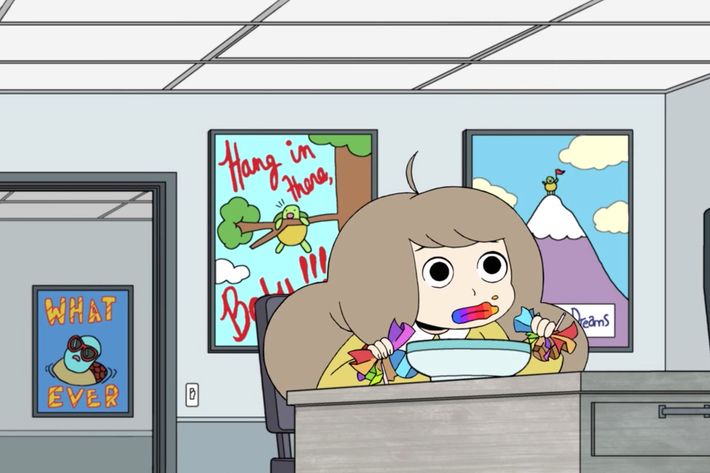
A final thing we have to talk about: One of the best parts of the pilot episode is the weird posters at the temp agency Bee goes to. No one acknowledges them, but they all have turtles on them and they have confusing slogans like “WHAT EVER” and “When life gives you lemons, crawl in your shell.”
I struggled to come up with what to leave with those stupid posters; I had so many, and then my favorite one didn’t get put in! [Laughs.]
Wait, what was the one that didn’t get put in?
I did one that was, “Burn In Shell.” Kind of like “burn in hell,” and it was a turtle with its shell on fire and it was, like, riding a motorcycle, I think.




